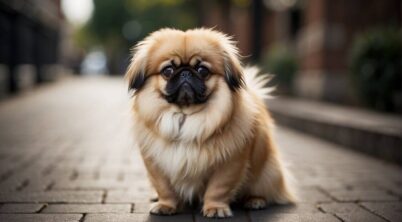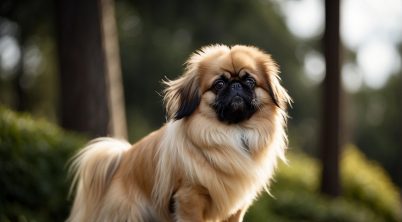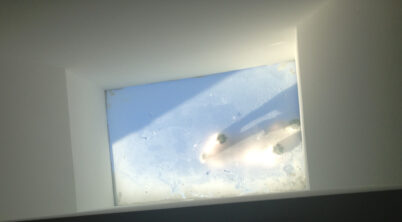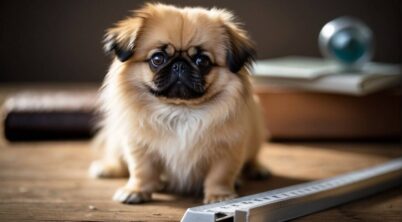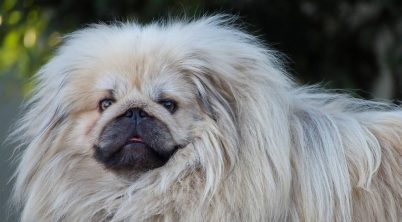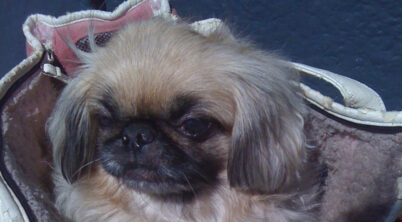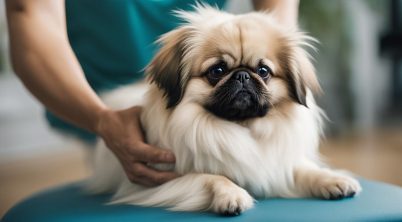Pekingese dogs are known for their distinct appearance, characterized by a lion-like mane, flat faces, and a short, stocky stature that belies their royal ancestry. Originating from China, these dogs were revered by ancient Chinese emperors and have since found a place in many homes as cherished companions. However, for those concerned with allergies, Pekingese may not be the ideal choice. Despite their popularity, they are not considered hypoallergenic due to their tendency to shed and produce pet dander, which are common triggers for allergic reactions.
People with allergies who are interested in dog ownership often seek hypoallergenic breeds in hopes of finding a pet that is less likely to provoke an allergic response. While the term ‘hypoallergenic’ suggests a reduced potential for causing allergies, no dog breed is completely free of allergens. In the case of the Pekingese, potential owners should be aware that the breed’s long and dense fur requires regular grooming to manage shedding, which can help minimize the presence of allergens in the home environment.
Management and regular grooming can reduce, but not eliminate, allergens for sensitive individuals considering a Pekingese as a pet. They should also consider spending time with a Pekingese to observe their personal reaction before making a commitment. For those with severe allergies, it may be worth consulting with an allergist or considering one of the dog breeds known for minimal shedding and dander production.
Table of Contents
Are Pekingese Dogs Hypoallergenic?
Pekingese dogs, known for their regal bearing and distinct lion-like mane, are a breed with ancient Chinese origins. However, they are not considered to be hypoallergenic. The breed is characterized by a long, luxurious coat that sheds periodically.
Shedding and Dander:
- Frequent shedding is common with Pekingese, contributing to indoor allergens.
- They produce dander, the primary source of allergens related to pets.
Despite their plush appearance, the Pekingese’s shedding tendencies can pose challenges to allergy sufferers. These dogs have a double coat consisting of a thick undercoat and a longer topcoat, which increases the amount of hair and dander in the environment.
Coat Grooming:
- Regular grooming is essential to minimize shedding.
- Bathing can help reduce the amount of loose hair and dander.
Considerations for Allergy Sufferers:
- While no dog is completely hypoallergenic, other breeds may be more suitable for individuals with sensitivities.
- Allergic reactions can vary, so exposure to a Pekingese before deciding to own one could be beneficial.
In summary, individuals with allergies to dog dander may need to explore other breeds typically known for their hypoallergenic nature. Pekingese dogs, with their frequent shedding and dander production, are generally not the best option for those seeking an allergy-friendly companion.
Breed Characteristics
The Pekingese, often affectionately referred to as the “lion dog,” is a compact and muscular breed with a distinct appearance and temperament. With its origins in ancient China, this breed carries a regal dignity that belies its small size.
Size and Body: Typically, the Pekingese stands at 6-9 inches in height and weighs up to 14 pounds. It possesses a stronger, stockier build than one might expect from a toy breed, with a characteristic rolling gait that reflects its confidence.
Coat: This breed sports a double coat—with a coarse, longer outer coat and a soft, thick undercoat—giving it a mane-like appearance that enhances its lion-like visage. Regular grooming is necessary to maintain their coat’s quality and to minimize shedding.
Temperament: The demeanor of the Pekingese is best described as dignified and opinionated. Known to be somewhat stubborn, they can be quite affectionate with their families. Despite their size, they are well-regarded as an alert watchdog, capable of sounding a bark that is surprisingly powerful for their petite form.
Breathing: As a brachycephalic breed, they have a short snout, which gives them a unique facial structure but can also lead to respiratory challenges.
The American Kennel Club recognizes the Pekingese as an expressive breed: their large, dark eyes and the characteristic V-shaped facial wrinkle contributing to their expressive demeanor. They can, on occasion, show an aggressive streak, so socialization from a young age is important. Their independence and loyalty make them a treasured companion for those who appreciate the breed’s complex nature.
Hypoallergenic Properties
In exploring the suitability of the Pekingese breed for allergy sufferers, it is paramount to examine specific allergen factors and the comparison of hypoallergenic breeds.
Allergen Factors
The Pekingese dog, with its double coat, is not a hypoallergenic breed. Shedding is a frequent occurrence in Pekingese, leading to a substantial presence of allergenic dander in the environment. This dander, along with saliva and urine, contains proteins that can trigger allergic reactions in sensitive individuals. The volume of dander can increase due to the dog’s abundant, floor-length fur, demanding regular grooming.
Comparing Hypoallergenic Breeds
While Pekingese are not hypoallergenic, there are other breeds that are considered more suitable for people with allergies due to their minimal shedding and dander production. These breeds include:
- Bichon Frise: Known for its fluffy coat that requires regular maintenance.
- Maltese: Features straight, long white hair with lightweight shedding.
- Yorkshire Terrier: Has a continuous hair growth similar to human hair.
- Poodles: Including standard, miniature, and toy sizes, have curly, dense coats.
- Coton de Tulear: Possesses a cotton-like coat with minimal shedding.
- Miniature Schnauzer: Sports a wiry coat with little to no shedding.
- Portuguese Water Dog: Noted for its waterproof coat and energetic temperament.
- Bolognese: Has a fluffy coat but does not shed much.
- Löwchen: Also known as the “Little Lion Dog,” with a low-shedding coat.
These breeds tend to leave less fur around the house, making them preferable for those with allergies. Regular grooming plays a crucial role in maintaining these hypoallergenic properties.
Grooming and Maintenance
Proper grooming and consistent maintenance are crucial for Pekingese due to their long, double coat which is prone to shedding and tangling. Attention to coat care and effective management of shedding season can help maintain the breed’s appearance and reduce allergenic dander in the home.
Coat Care
The Pekingese breed is known for its luxurious double coat, which requires regular grooming to prevent matting and maintain overall health. Brushing should occur several times a week with a suitable brush to effectively reach both the soft undercoat and the rougher outer coat. It is recommended to use a stainless steel comb for areas prone to tangling and a slicker brush to smoothly work through the coat, taking care not to pull or damage the hair.
- Tools: Stainless steel comb, slicker brush
- Frequency: Several times a week
Managing Shedding Season
Shedding season can be an intensive period for Pekingese owners as these dogs will lose larger amounts of hair, usually during the fall and spring. Increased brushing during these times can significantly reduce the amount of loose fur. Vacuuming the environment frequently can also help control the spread of shed hair and associated dander, which are common allergens related to dog proteins. In addition to regular brushing, it’s advisable to incorporate a quality vacuum cleaner designed to handle pet hair.
- Brushing: Increase frequency during shedding seasons
- Home maintenance: Regular vacuuming to reduce allergens
Living with a Pekingese
Living with a Pekingese involves understanding their unique maintenance needs and companionship qualities. Thorough knowledge of their health care will ensure a mutually rewarding relationship.
Healthcare and Wellness
The Pekingese is a breed that requires conscientious attention to its health care and wellness routines. Their long, fluffy coats are not hypoallergenic and necessitate regular grooming to manage shedding. Allergens from their fur and dander can affect individuals with dog allergies. Therefore, it’s essential to incorporate frequent grooming and possibly employ air purifiers to reduce allergic reactions in the home.
Routine veterinary care is critical for a Pekingese’s well-being. These dogs may exhibit health issues, such as respiratory problems due to their flat faces, and require regular check-ups to monitor their health status.
Regarding diet and nutrition, serving high-quality food tailored to their size and energy level is important. The breed has modest exercise needs, so a balanced diet helps prevent obesity. They should have daily physical activity, though vigorous exercise is not recommended due to their potential for respiratory difficulties.
Pekingese are affectionate companions, but they also have an independent streak, which can pose challenges in training and housebreaking. Consistency and patience are crucial in their training regimen.
In summary, when caring for a Pekingese, it is essential to maintain their health and wellness through regular grooming, appropriate exercise, a balanced diet, and vigilant veterinary care—key factors to their longevity and quality of life.

